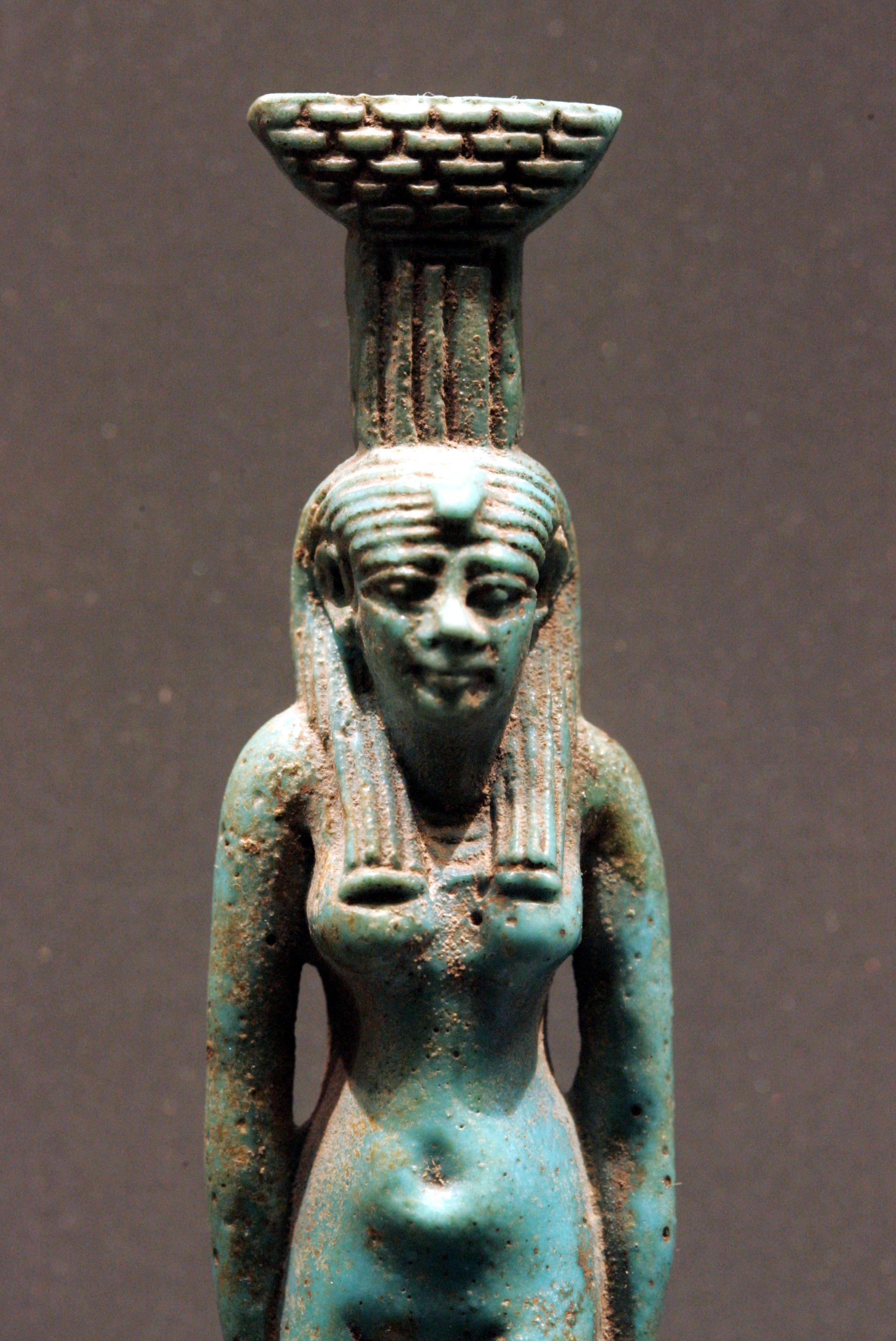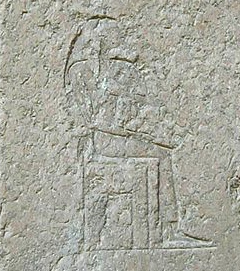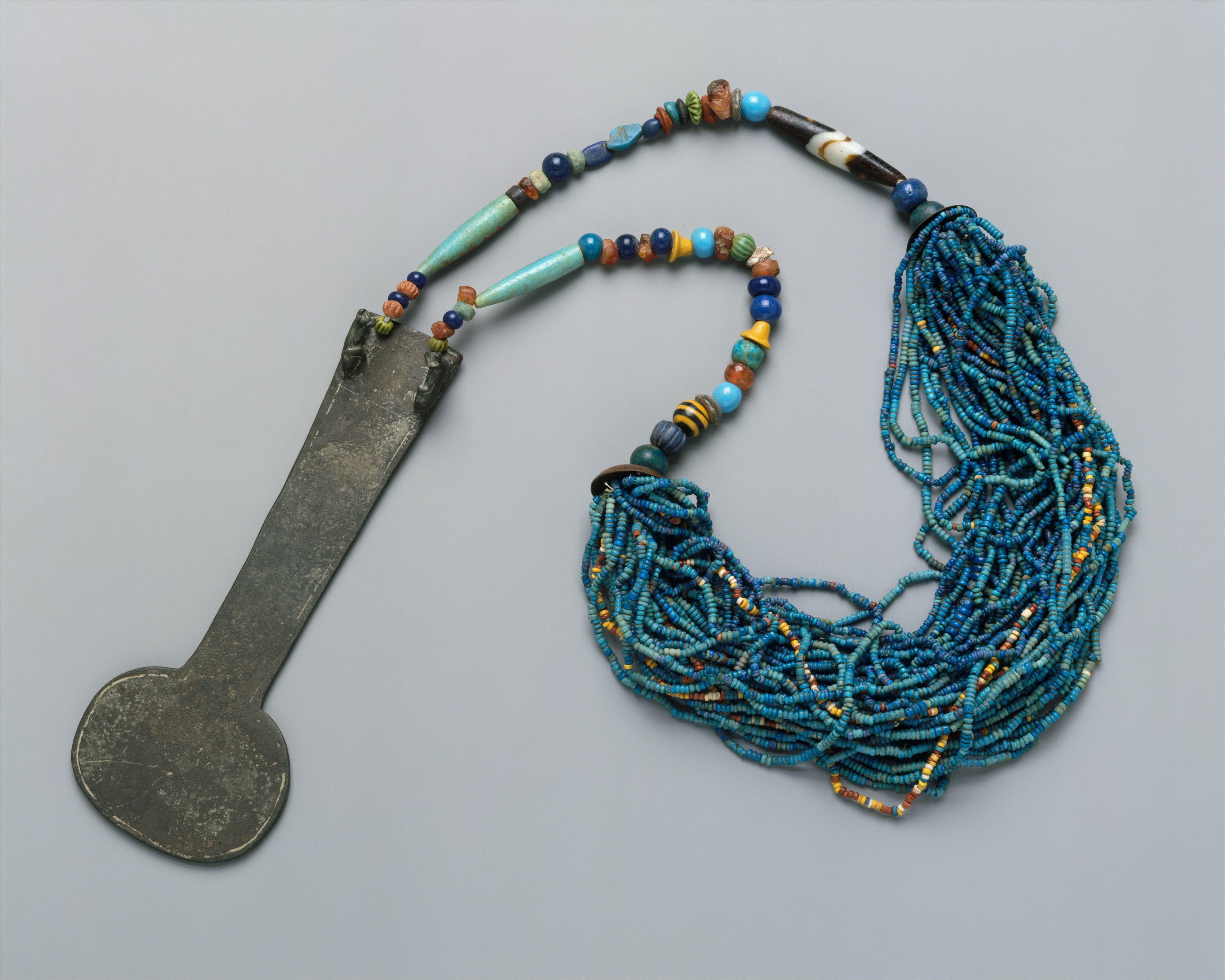|
Ruddedet
Rededjet (also readed as Ruddedet) is the name of a fictitious ancient Egyptian woman appearing as the heroic character in a story told in the legendary Westcar Papyrus. She is said to have fulfilled a prophecy by giving birth to three future kings that was forecast during the reign of Khufu ( Fourth Dynasty) by a magician named Dedi. Literary person Rededjet appears only in the fifth story of the Westcar Papyrus; no archeological or historical evidence of her existence has been discovered. Nevertheless, she is object of great interest for historians and Egyptologists, since her story gives information about the line of succession at the very beginning of the Fifth Dynasty and two royal women. The wonder of Rededjet According to the Westcar Papyrus, Rededjet has a strong labor, and birth is difficult because she has to deliver triplets. The god Ra, Lord of Sachebu, says to the deities Isis, Nephthys, Meskhenet, Heqet, and Khnum: “May you all go to Rededjet and release her f ... [...More Info...] [...Related Items...] OR: [Wikipedia] [Google] [Baidu] |
Westcar Papyrus
The Westcar Papyrus (inventory-designation: ''P. Berlin 3033'') is an ancient Egyptian text containing five stories about miracles performed by priests and magicians. In the papyrus text, each of these tales are told at the royal court of king Khufu (Cheops) ( Fourth Dynasty) by his sons. The story in the papyrus usually is rendered in English as, "King Cheops and the Magicians" and "The Tale of King Cheops' Court". In German, into which the text of the Westcar Papyrus was first translated, it is rendered as ''Die Märchen des Papyrus Westcar'' ("the fairy tales of Papyrus Westcar"). The surviving material of the Westcar Papyrus consists of twelve columns written in hieratic script. Miriam Lichtheim dates the document to the Hyksos period (eighteenth to sixteenth century BC) and states that it is written in classical Middle Egyptian. Linguist and Egyptologist thinks it is possible that the Westcar Papyrus was written during the Thirteenth Dynasty. The papyrus has been used b ... [...More Info...] [...Related Items...] OR: [Wikipedia] [Google] [Baidu] |
Fiction
Fiction is any creative work, chiefly any narrative work, portraying individuals, events, or places that are imaginary, or in ways that are imaginary. Fictional portrayals are thus inconsistent with history, fact, or plausibility. In a traditional narrow sense, "fiction" refers to written narratives in prose often referring specifically to novels, novellas, and short stories. More broadly, however, fiction encompasses imaginary narratives expressed in any medium, including not just writings but also live theatrical performances, films, television programs, radio dramas, comics, role-playing games, and video games. Definition Typically, the fictionality of a work is publicly marketed and so the audience expects the work to deviate in some ways from the real world rather than presenting, for instance, only factually accurate portrayals or characters who are actual people. Because fiction is generally understood to not fully adhere to the real world, the themes a ... [...More Info...] [...Related Items...] OR: [Wikipedia] [Google] [Baidu] |
Nephthys
Nephthys or Nebet-Het in ancient Egyptian ( grc-gre, Νέφθυς) was a goddess in ancient Egyptian religion. A member of the Great Ennead of Heliopolis in Egyptian mythology, she was a daughter of Nut and Geb. Nephthys was typically paired with her sister Isis in funerary ritesAbeer El-Shahawbooks.google.co.uk''The funerary art of Ancient Egypt: a bridge to the realm of the hereafter'' (106 pages) American University in Cairo Press, 2005 etrieved 2011-12-12/ref> because of their role as protectors of the mummy and the god Osiris and as the sister-wife of Set. She was associated with mourning, the night/darkness, service (specifically temples), childbirth, the dead, protection, magic, health, embalming, and beer. Etymology Nephthys is the Greek form of an epithet (transliterated as ''Nebet-hut'', ''Nebet-het'', ''Nebt-het'', from Egyptian ''nbt-ḥwt''). The origin of the goddess Nephthys is unclear but the literal translation of her name is usually given as ''Lady o ... [...More Info...] [...Related Items...] OR: [Wikipedia] [Google] [Baidu] |
Barley
Barley (''Hordeum vulgare''), a member of the grass family, is a major cereal grain grown in temperate climates globally. It was one of the first cultivated grains, particularly in Eurasia as early as 10,000 years ago. Globally 70% of barley production is used as animal fodder, while 30% as a source of fermentable material for beer and certain distilled beverages, and as a component of various foods. It is used in soups and stews, and in barley bread of various cultures. Barley grains are commonly made into malt in a traditional and ancient method of preparation. In 2017, barley was ranked fourth among grains in quantity produced () behind maize, rice and wheat. Etymology The Old English word for barley was ', which traces back to Proto-Indo-European and is cognate to the Latin word ' "flour" (''see corresponding entries''). The direct ancestor of modern English ''barley'' in Old English was the derived adjective ''bærlic'', meaning "of barley". The first citation ... [...More Info...] [...Related Items...] OR: [Wikipedia] [Google] [Baidu] |
Neferirkare
Neferirkare (sometimes referred to as Neferirkare II because of Neferirkare Kakai) was an ancient Egyptian pharaoh of the Eighth Dynasty during the early First Intermediate Period (2181–2055 BC). According to the egyptologists Kim Ryholt, Jürgen von Beckerath and Darrell Baker he was the 17th and final king of the Eighth Dynasty.Kim Ryholt: "The Late Old Kingdom in the Turin King-list and the Identity of Nitocris", Zeitschrift für ägyptische, 127, 2000, p. 99Darrell D. Baker: The Encyclopedia of the Pharaohs: Volume I - Predynastic to the Twentieth Dynasty 3300–1069 BC, Stacey International, , 2008, p. 260 Jürgen von Beckerath: ''Handbuch der ägyptischen Königsnamen'', Münchner ägyptologische Studien, Heft 49, Mainz : P. von Zabern, 1999, available online see p. 68 Many scholars consider Neferirkare to have been the last pharaoh of the Old Kingdom, which came to an end with the 8th Dynasty. Attestations Neferirkare II's name is clearly attested on the 56th entr ... [...More Info...] [...Related Items...] OR: [Wikipedia] [Google] [Baidu] |
Sahure
Sahure (also Sahura, meaning "He who is close to Re") was a pharaoh of ancient Egypt and the second ruler of the Fifth Dynasty (c. 2465 – c. 2325 BC). He reigned for about 13 years in the early 25th century BC during the Old Kingdom Period. Sahure's reign marks the political and cultural high point of the Fifth Dynasty. He was probably the son of his predecessor Userkaf with Queen NeferhetepesII, and was in turn succeeded by his son Neferirkare Kakai. During Sahure's rule, Egypt had important trade relations with the Levantine coast. Sahure launched several naval expeditions to modern-day Lebanon to procure cedar trees, slaves and exotic items. His reign may have witnessed the flourishing of the Egyptian navy, which included a high-seas fleet as well as specialized racing boats. Relying on this, Sahure ordered the earliest attested expedition to the land of Punt, which brought back large quantities of myrrh, malachite and electrum. Sahure is shown celebrating the succes ... [...More Info...] [...Related Items...] OR: [Wikipedia] [Google] [Baidu] |
Lapis Lazuli
Lapis lazuli (; ), or lapis for short, is a deep-blue metamorphic rock used as a semi-precious stone that has been prized since antiquity for its intense color. As early as the 7th millennium BC, lapis lazuli was mined in the Sar-i Sang mines,David Bomford and Ashok Roy, ''A Closer Look- Colour'' (2009), National Gallery Company, London, () in Shortugai, and in other mines in Badakhshan province in northeast Afghanistan. Lapis lazuli artifacts, dated to 7570 BC, have been found at Bhirrana, which is the oldest site of Indus Valley civilisation. Lapis was highly valued by the Indus Valley Civilisation (7570–1900 BC). Lapis beads have been found at Neolithic burials in Mehrgarh, the Caucasus, and as far away as Mauritania. It was used in the funeral mask of Tutankhamun (1341–1323 BC). By the end of the Middle Ages, lapis lazuli began to be exported to Europe, where it was ground into powder and made into ultramarine, the finest and most expensive of all blue pigments ... [...More Info...] [...Related Items...] OR: [Wikipedia] [Google] [Baidu] |
Userkaf
Userkaf (known in Ancient Greek as , ) was a pharaoh of ancient Egypt and the founder of the Fifth Dynasty. He reigned for seven to eight years in the early 25th century BC, during the Old Kingdom period. He probably belonged to a branch of the Fourth Dynasty royal family, although his parentage is uncertain; he could have been the son of Khentkaus I. He had at least one daughter and very probably a son, Sahure, with his consort Neferhetepes. This son succeeded him as pharaoh. His reign heralded the ascendancy of the cult of Ra, who effectively became Egypt's state god during the Fifth Dynasty. Userkaf may have been a high-priest of Ra before ascending the throne, and built a sun temple, known as the '' Nekhenre'', between Abusir and Abu Gurab. In doing so, he instituted a tradition followed by his successors over a period of 80 years. The ''Nekhenre'' mainly functioned as a mortuary temple for the setting sun. Rites performed in the temple were primarily concerned with R ... [...More Info...] [...Related Items...] OR: [Wikipedia] [Google] [Baidu] |
Sistrum
A sistrum (plural: sistra or Latin sistra; from the Greek ''seistron'' of the same meaning; literally "that which is being shaken", from ''seiein'', "to shake") is a musical instrument of the percussion family, chiefly associated with ancient Egypt. It consists of a handle and a U-shaped metal frame, made of brass or bronze and between 30 and 76 cm in width. When shaken, the small rings or loops of thin metal on its movable crossbars produce a sound that can be from a soft clank to a loud jangling. Its name in the ancient Egyptian language was sekhem ''(sḫm)'' and sesheshet ''(sššt).'' Sekhem is the simpler, hoop-like sistrum, while sesheshet (an onomatopoeic word) is the naos-shaped one. The modern day West African disc rattle instrument is also called a sistrum. Egyptian sistrum The sistrum was a sacred instrument in ancient Egypt. Perhaps originating in the worship of Bat, it was used in dances and religious ceremonies, particularly in the worship of the godd ... [...More Info...] [...Related Items...] OR: [Wikipedia] [Google] [Baidu] |
Menit
In ancient Egyptian religion, a menat ( egy, mnj.t, ar, منات) was a type of artefact closely associated with the goddess Hathor. Operation The menat was held in the hand by its counterpoise and used as a rattle by Hathor's priestesses. It was also worn as a protective amulet, particularly by Apis bulls. Parts The menat typically included an aegis attached to beaded strings. The other ends of the strings were tied to a counterweight that dangled on the wearer's back. The aegis was often made of faience, but other materials such as leather and bronze were also used. It was often inscribed or bore depictions of deities associated with Hathor. Purpose The necklace was meant to ensure good luck and fortune and to protect against evil spirits. It was also worn for protection in the afterlife and is often found buried with the dead, given as a grave gift since Ramesside times . It was expected to foster fruitfulness and good health for women, and for men it signified virili ... [...More Info...] [...Related Items...] OR: [Wikipedia] [Google] [Baidu] |
Shapeshifting
In mythology, folklore and speculative fiction, shape-shifting is the ability to physically transform oneself through an inherently superhuman ability, divine intervention, demonic manipulation, sorcery, spells or having inherited the ability. The idea of shape-shifting is in the oldest forms of totemism and shamanism, as well as the oldest existent literature and epic poems such as the ''Epic of Gilgamesh'' and the ''Iliad''. The concept remains a common literary device in modern fantasy, children's literature and popular culture. Folklore and mythology Popular shape-shifting creatures in folklore are werewolves and vampires (mostly of European, Canadian, and Native American/early American origin), ichchadhari naag and ichchadhari naagin (shape-shifting cobras) of India, the huli jing of East Asia (including the Japanese ''kitsune'' and Korean ''kumiho''), and the gods, goddesses, and demons and demonesses like succubus and incubus and other numerous mythologies, s ... [...More Info...] [...Related Items...] OR: [Wikipedia] [Google] [Baidu] |
Sacrifice
Sacrifice is the offering of material possessions or the lives of animals or humans to a deity as an act of propitiation or worship. Evidence of ritual animal sacrifice has been seen at least since ancient Hebrews and Greeks, and possibly existed before that. Evidence of ritual human sacrifice can also be found back to at least pre-Columbian civilizations of Mesoamerica as well as in European civilizations. Varieties of ritual non-human sacrifices are practiced by numerous religions today. Terminology The Latin term ''sacrificium'' (a sacrifice) derived from Latin ''sacrificus'' (performing priestly functions or sacrifices), which combined the concepts ''sacra'' (sacred things) and ''facere'' (to do or perform). The Latin word ''sacrificium'' came to apply to the Christian eucharist in particular, sometimes named a "bloodless sacrifice" to distinguish it from blood sacrifices. In individual non-Christian ethnic religions, terms translated as "sacrifice" include the Indic ... [...More Info...] [...Related Items...] OR: [Wikipedia] [Google] [Baidu] |








